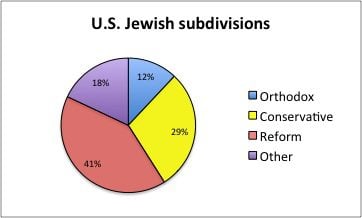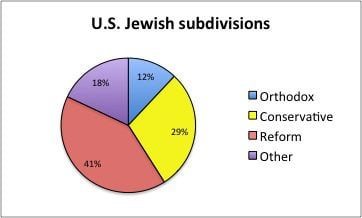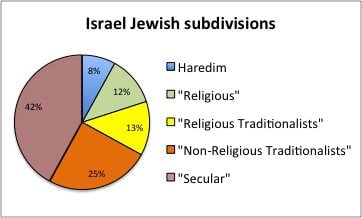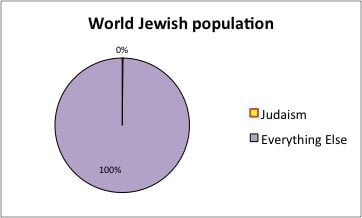In my last blog entry, I presented some statistics and some graphic “pie charts” to illustrate (for the benefit of those for whom religious demographics may be unfamiliar territory) the actual size of both the total world Jewish population, as well as the total U.S. Jewish population, in comparison with the total global and total American populations, respectively.
I also looked, in that entry, at how the total world Jewish populace is distributed around the globe. The numbers clearly indicated that the overwhelming majority of Jews worldwide (a total of some 82% of the Jewish people) live either in Israel or the U.S.
In this blog entry, I’d like to next take a closer look at Judaism itself, at some of the major subdivisions that can be found within it, and at how large or small these major subdivisions are, relative to each other.
None of the major world religions is “homogenous,” in the sense of being the same everywhere, through and through, or existing in only one single form, one sole and universal “version.” All of the major religions are characterized by internal diversity; multiple forms or “versions” of each exist, alongside each other.
Each major world faith, in other words, subdivides into a number of sects, subgroups, or subdivisions. Islam, for example, has its Sunni and Shi’a branches; Buddhism has its Theravada and its Mahayana wings; Christianity splits broadly into Catholic, Orthodox, and Protestant divisions (with Protestantism itself further subdividing into numerous denominations and nondenominational groups).
Judaism is no exception to this common pattern, so frequently found among the major world faiths.
The United States is, by far, the nation with the second largest Jewish population in the world. Some 39% of the world’s Jews call America home. And in the U.S. today, most Jews belong to one of three major branches, divisions, movements, or “denominations” which currently dominate American Judaism: Orthodox Judaism, Conservative Judaism, and Reform Judaism.
For most of the last 2000 years or so, there were no such major divisions within Judaism. Rabbinic Judaism was just Judaism, period. Virtually all of Judaism was basically equivalent to what we today refer to more narrowly as “Orthodox Judaism.” But until relatively recent times, traditionally normative Judaism simply didn’t need to add that additional adjective (explicitly specifying “orthodoxy”). It was just “Judaism” — the one and only kind.
Then, in the 18th century, as the Western world began to modernize, some Jews wanted to be a part of that widespread Western cultural modernization, rather than be left out or left behind — to be a part of the emerging mainstream, and to avoid further marginalization. These Jews began to look at their traditional Jewish beliefs and practices through the questioning eyes of modernity; they sought to “modernize” Judaism to some degree, to bring it into the modern era by distilling it down to what in their view really counted most, and was most compatible with modernity, while retaining what seemed to them to be Judaism’s most important core principles and enduring values.
The result of this modernizing attempt or “reform movement” within Judaism came to be known as Reform Judaism.
Meanwhile, the rest of Judaism — the “old school,” very traditional, very “orthodox” kind — came to be referred to specifically as Orthodox Judaism. It had always been around; it merely adopted this lengthier descriptive label in order to distinguish it from the emerging Reform Judaism.
Still later, some other Jews generally agreed with and admired (to an extent) what Reform Judaism was trying to accomplish, while on the other hand also feeling that the Reform movement had gone a bit too far in watering down some of the still-important fundamentals (in their own view) of traditional Judaism.
The result was the appearance of Conservative Judaism as an even more recent division, occupying a sort of midway position between Orthodox Judaism on the one hand (very traditional and conservative), and Reform Judaism (very liberal and progressive) on the other hand.
Rounding out the picture are the various Haredim (or so-called “ultra-Orthodox” groups, although that term is not always favorably used or received). These groups are a subset within Orthodox Judaism, and exist at the most religiously conservative and traditional end of the broad Jewish spectrum; perhaps the best-known among these Haredi groups in America today would probably be the Hasidic community. (The other main subset within Orthodox Judaism is often referred to as “Modern Orthodox.”)
Most American Jews today identify with, or are affiliated with, one of these three major Jewish “denominations”: Orthodox, Conservative, or Reform.
The largest single slice of the American Jewish “pie” belongs to Reform Judaism; Conservative Judaism is a strong second-place runner-up, while Orthodox Judaism comes in a somewhat distant third.
The “Other” category is something of a catch-all; it includes much smaller movements, such as Reconstructionist Judaism (perhaps around 2%), along with secular or non-religious Jews who may not be religiously observant, or who do not affiliate or identify with any of these three major Jewish “denominations” or movements.
The U.S. is home to the second largest Jewish community in the world (amounting to 39% of world Jewry), and is outstripped in this respect only by the nation of Israel itself (home to 43% of the world’s Jews). However, in Israel, the major Jewish “categories” are quite different from those predominant within the U.S., making direct comparisons difficult.
Most Israeli Jews do not belong to any such organized movement or formal “denomination”, as is common in America. Instead, Jews in Israel tend to rate themselves simply in terms of how religiously “observant” they are, along a broad and somewhat vague spectrum ranging from “secular” (not very observant) to “traditional” (very observant):
The formal categories may be different, but the overall spectrum of distribution seems similar in principle.




